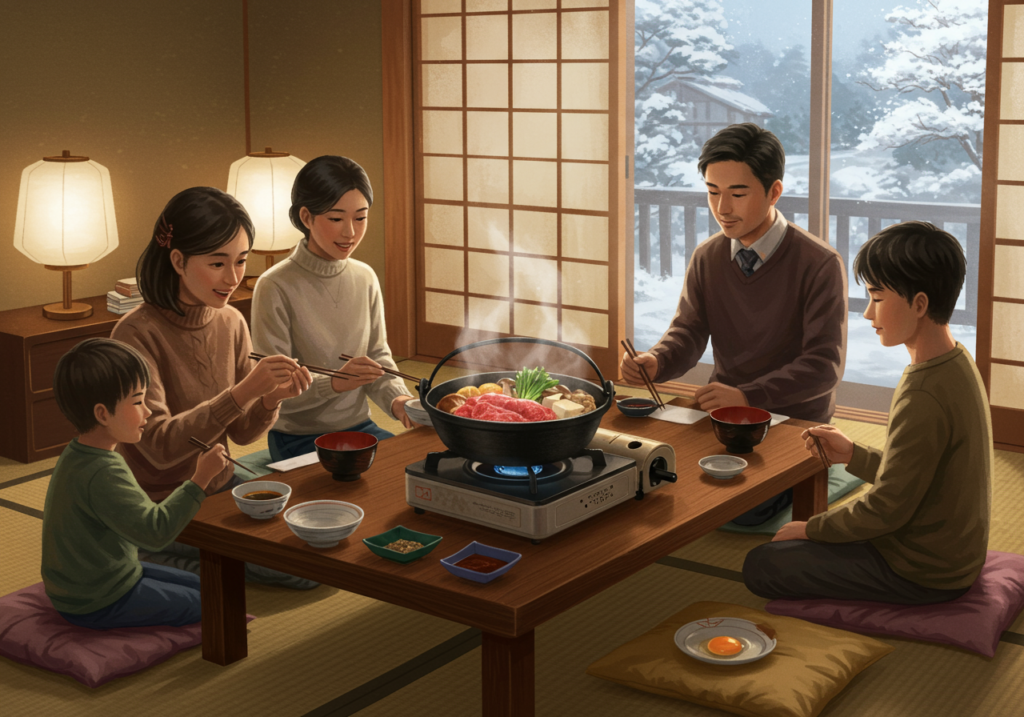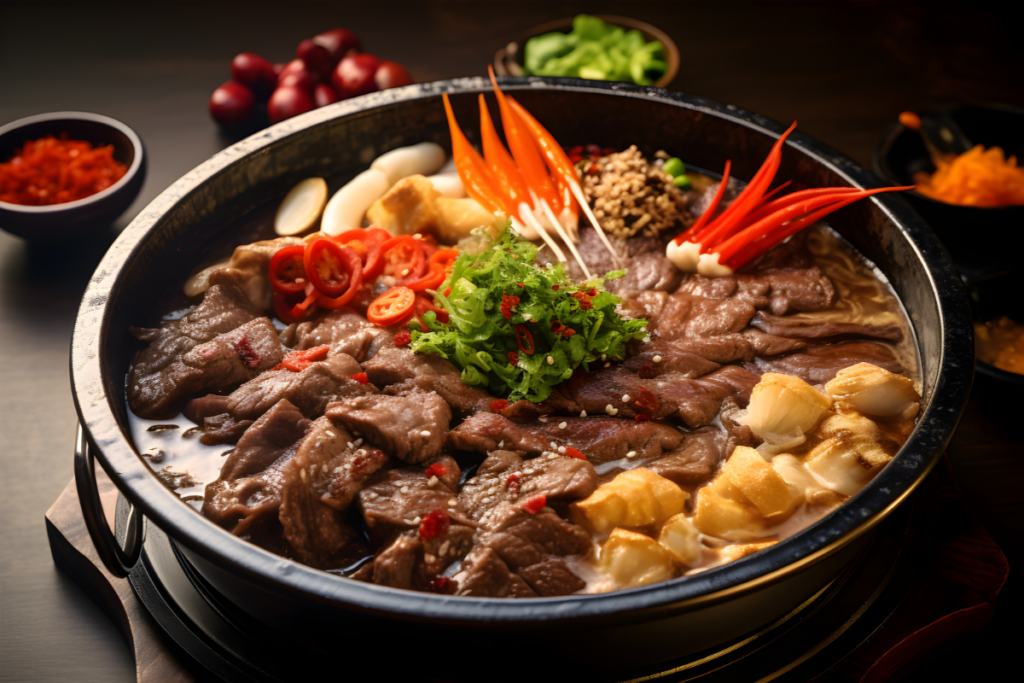What Is Sukiyaki? (すき焼きとは何ですか)
Origins and History
Sukiyaki (すき焼き) originated during the late Edo to early Meiji period, around the late 19th century, when Japan began opening up to Western culinary influences. As beef consumption became more acceptable—once prohibited by Buddhist tradition—beef sukiyaki (牛 すきやき) rose in popularity as a celebratory dish. It blends traditional Japanese cooking with a Western appreciation for beef, cooked right at the dining table.
Table of Contents
ToggleCultural Significance in Japan
Today, Japanese dish sukiyaki (日本の料理「すき焼き」) holds a special place in family gatherings, particularly during the cold winter months. It’s often served during bonenkai (year-end parties) and New Year’s feasts, symbolizing warmth, sharing, and unity. Learn more about Japanese winter traditions here.
Differences from Other Japanese Hot Pot Dishes
Unlike shabu-shabu, where ingredients are briefly swished in a clear broth, sukiyaki simmers ingredients in a rich, sweet-salty soy-based sauce called warishita. Sukiyaki emphasizes a harmonious blend of beef, vegetables, and umami-rich sauce, while nabe and oden prioritize broths.
Essential Ingredients for Authentic Sukiyaki
Beef and Protein Choices
The hero of any sukiyaki meat recipe (すき焼き 肉レシピ) is thinly sliced, high-quality beef—often wagyu or kuroge wagyu. The marbling of fat is essential for tender, melt-in-your-mouth texture. Pork and chicken are alternatives, especially in regions where beef is less common.
Vegetables and Mushrooms
Traditional sukiyaki vegetables (すき焼き野菜) include napa cabbage (白菜), green onions (長ねぎ), and shungiku (春菊 – edible chrysanthemum greens). Mushrooms like shiitake (椎茸) and enoki (えのき茸) bring earthy depth to the dish.
Tofu, Noodles, and Other Additions
Silken or grilled tofu (焼き豆腐), konnyaku (こんにゃく noodles), and shirataki noodles (白滝) add texture. These ingredients soak up the sweet-savory warishita, balancing the richness of the meat.
Sukiyaki Sauce and Broth
Warishita: The Base Sauce
Warishita (割り下) is the essence of sukiyaki. Made from soy sauce (醤油), mirin (みりん), sugar (砂糖), and sake (酒), it delivers a balance of salty, sweet, and umami notes that define the dish.
Seasonings and Sweeteners
Sugar and mirin are essential in adjusting the sweetness. In some regions, brown sugar or honey is used for added complexity. A splash of sake helps tenderize the meat.
Role of Dashi and Other Broths
While not always used, a light dashi broth (だし) made from kombu (kelp) and katsuobushi (bonito flakes) may be added to enrich the flavor and prevent the sauce from becoming too thick during cooking.
Traditional Sukiyaki Cooking Methods

Kansai-Style Sukiyaki
In Osaka and Kyoto, beef is first grilled in a pan, then sugar is sprinkled over it before adding the sauce and vegetables. This dry-sear method enhances the caramelization of the meat.
Kanto-Style Sukiyaki
Tokyo’s Kanto-style sukiyaki starts with boiling warishita in the pot, into which all ingredients are added and simmered together. This style is more akin to traditional hot pot.
Tabletop Cooking and Portable Burners
A key part of the sukiyaki experience is its communal cooking style—guests cook together around a tabletop burner. It transforms a meal into a shared, participatory ritual. For a similar dining experience, check out our guide on nabe hot pot dining in Japan.
Dining Experience and Etiquette
How to Eat Sukiyaki
Use chopsticks to take meat or vegetables directly from the pot, dip in raw beaten egg (optional), and eat over steamed rice. It’s a slow-paced meal meant for conversation and enjoyment.
Raw Egg Dipping Tradition
The egg (卵) not only cools the hot food but also adds a velvety texture that contrasts beautifully with the savory sauce. While this may seem unusual to visitors, it’s a beloved element in Japan.
Accompaniments and Recommended Pairings
Sukiyaki pairs well with steamed white rice, light pickles (tsukemono), and even sake or shochu. Finish with udon or mochi added to the remaining broth.
Regional Variations Across Japan
Kansai Region (Osaka, Kyoto)
Beef is king in Kansai, where grilling it first before stewing is customary. Local wagyu like Matsusaka or Kobe beef elevates the dish.
Kanto Region
Here, simmering everything in warishita creates a mellow, sweet-savory profile. Tokyo’s sukiyaki often leans slightly sweeter.
Unique Local Styles and Seasonal Variations
Some areas add regional ingredients like apples in Nagano or seafood in coastal prefectures. Springtime sukiyaki may include Japanese maple (日本もみじ)-shaped fu (wheat gluten cakes) for visual appeal.
Sukiyaki Restaurants and Dining Out
What to Expect at Sukiyaki Restaurants
Expect an elegant setting with individual burners and attentive staff. Some offer private dining rooms with traditional tatami flooring.
Popular Sukiyaki Spots in Japan
Imahan in Asakusa: A Tokyo institution since the Meiji era.
Mishimatei in Kyoto: Historic sukiyaki with wagyu.
Morita-ya in Osaka: Home of Kansai-style sukiyaki.
Hotto Motto Sukiyaki (ほっと もっと すき焼き)
This popular bento chain offers affordable sukiyaki bento meals across Japan. It’s a great way to enjoy authentic flavors on the go.
Yoshinoya Sukiyaki (吉野家すき焼き)
Yoshinoya’s gyu-nabe sets combine their famous beef bowls with sukiyaki sauce. Available seasonally, it’s a budget-friendly favorite for travelers and locals alike.
Ordering Tips and Advice for Visitors
Always check if raw egg is included. Ask for yaki-dofu (grilled tofu) or extra vegetables if you’re vegetarian. Learn key phrases like “tamago tsuki desu ka?” (Is egg included?) for smoother communication.
Making Sukiyaki at Home
Sukiyaki Recipe Instructions
For a classic beef sukiyaki style recipe (牛肉 すき焼き風 レシピ):
Sauté beef lightly in oil.
Add warishita.
Add vegetables and tofu.
Simmer gently.
Serve with raw egg (optional).
Tips for Ingredient Selection
Use marbled beef, fresh mushrooms, and seasonal greens. If in Japan, visit local depachika (department store basements) for fresh cuts and specialty sauces.
Vegetarian and Dietary Variations
Replace beef with mushrooms or tofu. Use kombu dashi and tamari for a vegan-friendly base. Shirataki noodles are gluten-free.
Sukiyaki in Japanese Culture

Sukiyaki at Year-End Parties and Family Gatherings
Sukiyaki is a staple at bonenkai (忘年会), reflecting warmth and gratitude. Families gather around the pot, celebrating connection over hearty food.
Role in Festivals and Special Occasions
In rural Japan, sukiyaki is served at weddings, harvest festivals, and milestone birthdays. It symbolizes prosperity and shared happiness.
Frequently Encountered Ingredients and Substitutes
Local and Seasonal Ingredients
Spring herbs, summer eggplant, or autumn mushrooms like maitake give sukiyaki seasonal appeal. Winter is peak sukiyaki time.
Substitute Options for Overseas Cooks
Use thinly sliced ribeye or chuck if wagyu isn’t available. Soy-mirin-sugar mix can replace bottled warishita. Spinach, bok choy, and firm tofu work well as substitutes.
Health, Safety, and Nutrition
Health Benefits and Nutritional Value
Rich in protein, iron, and vitamins, sukiyaki is surprisingly balanced. When made with more vegetables, it’s a nutritious comfort dish.
Safe Handling of Raw Eggs and Beef
Always use pasteurized eggs and fresh, high-quality beef, especially when eating raw egg. Cook meat thoroughly if unsure.
Comparing Sukiyaki to Similar Dishes
Shabu-Shabu and Sukiyaki: Key Differences
Sukiyaki is sweeter and richer, with sauce-based cooking. Shabu-shabu uses broth and emphasizes dipping sauces post-cooking.
Hot Pot Dishes Around Japan
From chanko nabe (wrestler’s stew) to yosenabe, each region has its own take on communal one-pot meals.
Influence of Sukiyaki Abroad
In the West, sukiyaki has inspired dishes in Korean BBQ, Taiwanese hot pot, and even global fusion cuisine.
You might love these too
Let’s Stay Connected!
Our newsletter brings you peaceful places, meaningful traditions, and unseen beauty.
You might love these too
Let’s Stay Connected!
Our newsletter brings you peaceful places, meaningful traditions, and unseen beauty.
You might love these too
Let’s Stay
Connected!
Our newsletter brings you peaceful places, meaningful traditions, and unseen beauty.
